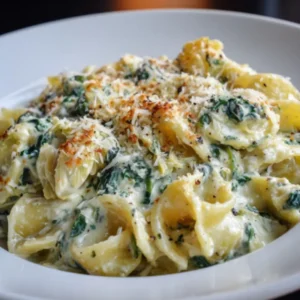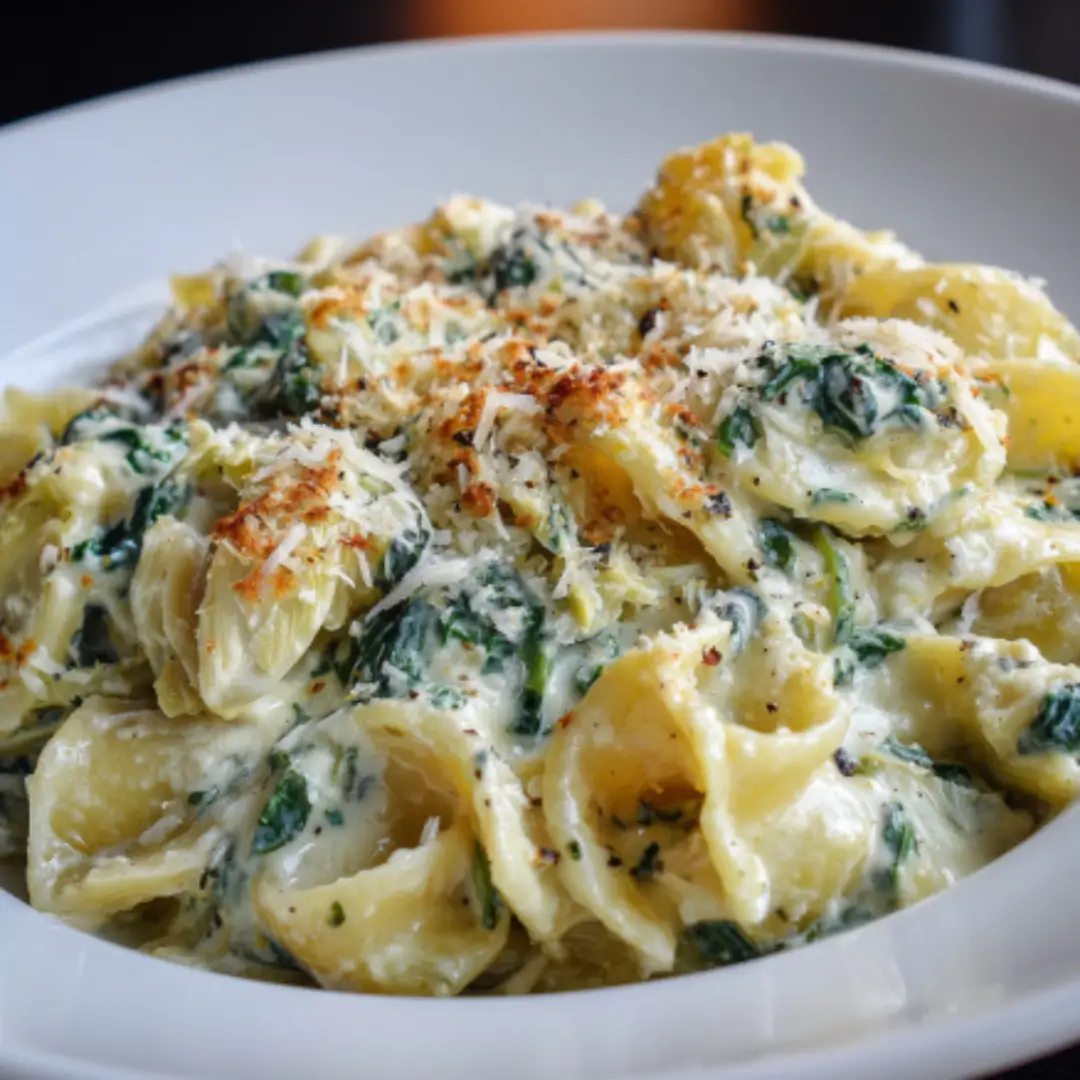Spinach Artichoke Pasta is a creamy and flavorful meal you can make without much effort. It takes the familiar taste of spinach artichoke dip and turns it into a satisfying dinner you can serve any night of the week. With tender pasta, cheesy sauce, and hearty vegetables, this recipe brings comfort and balance to your plate.
Why We Love This Spinach Artichoke Pasta Recipe
You’ll love this pasta for a few reasons. First, it’s creamy and cheesy without being overly rich. The use of reduced-fat cheeses and nonfat milk helps keep things lighter without sacrificing flavor. Second, it uses ingredients you probably already have or can easily find—frozen spinach, artichoke hearts, and high-fiber pasta all come together in a way that feels both familiar and special.
Another reason to make this dish? It’s the perfect blend of vegetables and comfort. The spinach adds a pop of color and nutrition, while the artichokes give the dish a satisfying texture. Plus, it’s easy to make in one pan, which means less cleanup afterward. That’s always a win.
Ingredients about Spinach Artichoke Pasta
To make this pasta dish, you’ll need a few pantry staples and some fresh ingredients. Each one plays a role in creating a rich, balanced flavor.
- 1 tsp olive oil
- 2 cloves garlic, minced
- 1 shallot, minced
- 1/2 tbsp flour (optional for low-carb or gluten-free)
- 1 cup nonfat milk
- 1/2 cup reduced-fat shredded mozzarella cheese
- 2 oz reduced-fat cream cheese
- 5 oz frozen chopped spinach, defrosted and well-drained
- 5 oz frozen artichoke hearts, defrosted and chopped
- 1/4 cup Parmesan cheese
- 8 oz high-fiber pasta
- Salt and pepper to taste
These ingredients come together in a way that makes the dish creamy and hearty, while still being light enough for a weekday dinner.
How to Make Spinach Artichoke Pasta Directions
Start by cooking your pasta according to the directions on the box. Be sure to reserve about 1/4 cup of the starchy cooking water before draining. You’ll use this later to help bind the sauce and give it the perfect texture.
While the pasta cooks, heat olive oil in a skillet over medium heat. Add in the garlic and minced shallots. Let them cook for 3–4 minutes, just until softened and fragrant. Stir in the flour next, which will help the sauce thicken. Let the flour brown slightly, stirring it into the oil and shallots.
Now slowly pour in the nonfat milk. Stir it well, and bring the mixture to a gentle boil. Once it begins to bubble, reduce the heat to low. Let it simmer for 3–4 minutes, stirring often, until it thickens into a smooth sauce.
Add the mozzarella and cream cheese into the sauce. Stir patiently as the cheeses melt and blend together, making everything creamy. You’ll want to taste the sauce at this stage and season it with salt and pepper to your liking.
Now it’s time to bring in the veggies. Stir in the drained spinach and chopped artichoke hearts. It’s important to squeeze all the extra moisture out of both—too much liquid can water down the sauce. Cook the vegetables in the sauce for about 3–4 minutes. Finish it off with a sprinkle of Parmesan cheese for an extra layer of flavor.
Once everything is creamy and well-mixed, pour the cooked pasta into the pan with the sauce. Toss everything together until the pasta is coated. If the sauce feels too thick, add a little bit of the reserved pasta water, one tablespoon at a time, until you reach your desired consistency.
If you want an extra step to level it up, transfer everything into an oven-safe dish and broil it for a few minutes. This gives the top a golden finish and adds a bit of texture that makes each bite even better.
How to Serve Spinach Artichoke Pasta
This pasta dish is rich enough to stand on its own, but you can also serve it with a few sides to round out the meal. A fresh green salad with a light dressing pairs well, balancing out the creamy pasta. You might also want to add a slice of toasted bread or garlic flatbread for something crunchy on the side.
If you’re entertaining, you can serve this pasta in a big casserole-style dish straight from the oven. The golden topping makes it look beautiful and inviting. For casual dinners, just spoon it straight from the pan into bowls. It’s one of those meals that feels warm and filling with every bite.
Expert Tips: Spinach Artichoke Pasta
To make this recipe even easier and more foolproof, here are a few helpful tips:
- Drain your vegetables well. This step is key. Spinach and artichokes hold a lot of water, which can ruin the sauce texture if you skip draining. Squeeze them in a towel or use a fine strainer.
- Use freshly grated Parmesan. Pre-shredded cheese often has anti-caking agents that can affect how it melts. Freshly grated cheese melts smoother and adds a sharper taste.
- Don’t skip the pasta water. That starchy water helps bind the sauce and gives it a silky finish. Even just a tablespoon or two makes a big difference.
- Try whole wheat or lentil pasta. If you’re looking to boost the fiber or protein content, swap in an alternative pasta that fits your dietary needs.
- Add heat if you like. A sprinkle of red pepper flakes can give the dish a subtle kick without overpowering the flavors.
How to Store Spinach Artichoke Pasta
If you have leftovers, store them in an airtight container in the fridge. The pasta will stay fresh for up to four days. When reheating, add a splash of milk or water to loosen the sauce, as it may thicken in the fridge.
You can reheat it in the microwave or gently warm it on the stove. Just stir frequently and heat until it’s warmed through. Avoid freezing this dish, as the creamy texture may separate once thawed.
Variation of Spinach Artichoke Pasta
There are plenty of ways to make this pasta dish your own, depending on what you have or what flavors you enjoy.
- Use fresh spinach. If you don’t have frozen spinach, use fresh instead. Just sauté it first until wilted, and then drain it well before adding to the sauce.
- Try different cheeses. Swap out mozzarella for Fontina or Monterey Jack for a different flavor profile. You can also add a touch of ricotta for extra creaminess.
- Make it spicy. A pinch of chili flakes or a spoonful of spicy pesto can bring a new layer of flavor.
- Add protein. Stir in cooked shredded chicken, white beans, or tofu to turn this into a heartier meal.
- Go gluten-free. Skip the flour or use gluten-free flour, and choose gluten-free pasta for a version that fits your dietary needs.
These swaps make the dish versatile and easy to adapt to your lifestyle.
FAQ
What type of pasta works best for spinach artichoke pasta?
You can use any pasta shape, but short types like penne, rotini, or rigatoni work well because they hold onto the sauce better. High-fiber or whole grain options are great for extra nutrition.
Can I use fresh artichokes instead of frozen?
Yes, but they take more time to prep. If you’re using fresh artichokes, cook and clean them ahead of time. Frozen or canned (unsalted and rinsed) are more convenient for weeknights.
How can I make spinach artichoke pasta dairy-free?
Use plant-based milk and cheeses. Many stores now carry dairy-free cream cheese and mozzarella alternatives that melt well and still give you a creamy sauce.
Why is my sauce watery?
This usually happens if the spinach or artichokes weren’t drained properly. Make sure to press out all the extra liquid before adding them to the sauce.
Is this dish good for meal prep?
Absolutely. You can prepare the sauce ahead and store it separately. Cook fresh pasta when you’re ready to eat, or reheat the full dish with a splash of milk to freshen it up.

Spinach Artichoke Pasta
Equipment
- Skillet
- Large Pot
- Mixing Bowl
Ingredients
- 1 teaspoon olive oil
- 2 cloves garlic minced
- 1/2 tablespoon flour optional for low-carb or gluten-free
- 1 cup nonfat milk
- 1/2 cup reduced-fat shredded mozzarella cheese
- 2 oz reduced-fat cream cheese
- 5 oz frozen chopped spinach defrosted and well-drained
- 5 oz frozen artichoke hearts defrosted and chopped
- 1/4 cup Parmesan cheese
- 8 oz high-fiber pasta
- Salt and pepper to taste
Instructions
- Cook the pasta according to package directions, reserving 1/4 cup of the starchy cooking water before draining.
- In a skillet over medium heat, heat olive oil and add garlic and shallots. Cook for 3-4 minutes until softened and fragrant.
- Stir in flour (if using) and let it brown slightly before slowly pouring in the nonfat milk. Bring to a gentle boil, then reduce heat and simmer for 3-4 minutes until thickened.
- Add mozzarella and cream cheese to the sauce, stirring until melted and creamy. Season with salt and pepper.
- Stir in drained spinach and chopped artichoke hearts, cooking for an additional 3-4 minutes. Sprinkle with Parmesan cheese.
- Toss the cooked pasta with the sauce, adding reserved pasta water as needed for desired consistency.
- If desired, transfer to an oven-safe dish and broil for a few minutes until golden.
Send me this recipe!
Just enter your email below and get it sent straight to your inbox!


